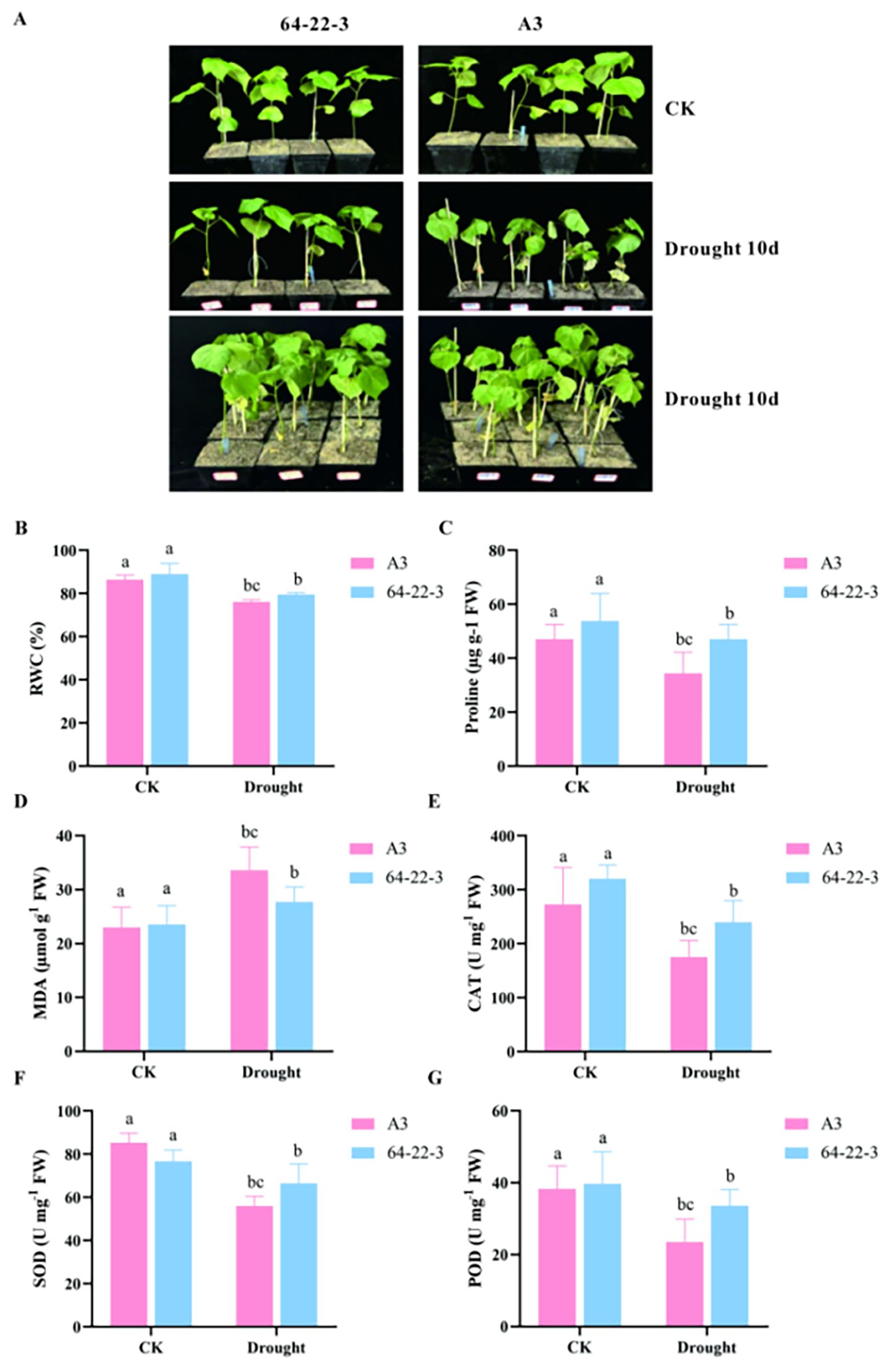- Xinjiang Key Laboratory of Special Species Conservation and Regulatory Biology, College of Life Science, Xinjiang Normal University, Urumqi, China
A Correction on
Comparative transcriptome and metabolome profiling unveil genotype-specific strategies for drought tolerance in cotton
By Han A, Fu W, Liusui Y, Zhong X, Zhang X, Wang Z, Li Y, Zhang J and Guo Y (2025). Front. Plant Sci. 16:1610552. doi: 10.3389/fpls.2025.1610552
In the published article, Figure 2A contains an error. Upon our verification, it was identified that the labels “A3” and “64-22-3” in Figure 2A were reversed: specifically, the image on the left should be labeled “64-22-3”, while the image on the right should be labeled “A3”. The corrected Figure 2 is provided below.

Figure 2. Phenotypic and physiological characterization of cotton under normal irrigation and drought conditions. Different lowercase letters indicate significant differences among treatment groups at p < 0.05 level. (A) Phenotypic comparison between normally irrigated and drought-stressed cotton plants; (B) Leaf relative water content (RWC, %) in control and drought-treated groups; (C) Proline content (Pro) under normal irrigation and drought stress; (D) Malondialdehyde content (MDA) in control and drought-exposed plants; (E) Catalase (CAT) activity in cotton under well-watered and drought-stress conditions. (F) Superoxide dismutase (SOD) content in cotton under well-watered and drought-stress conditions. (G) Peroxidase (POD) activity in cotton under well-watered and drought stress conditions.
The original version of this article has been updated.
Publisher’s note
All claims expressed in this article are solely those of the authors and do not necessarily represent those of their affiliated organizations, or those of the publisher, the editors and the reviewers. Any product that may be evaluated in this article, or claim that may be made by its manufacturer, is not guaranteed or endorsed by the publisher.
Keywords: cotton, drought-resistant varieties, transcriptome, metabolome, hub gene
Citation: Han A, Fu W, Liusui Y, Zhong X, Zhang X, Wang Z, Li Y, Zhang J and Guo Y (2025) Correction: Comparative transcriptome and metabolome profiling unveil genotype-specific strategies for drought tolerance in cotton. Front. Plant Sci. 16:1699493. doi: 10.3389/fpls.2025.1699493
Received: 05 September 2025; Accepted: 14 October 2025;
Published: 21 October 2025.
Edited and reviewed by:
Deepanker Yadav, Guru Ghasidas Vishwavidyalaya, IndiaCopyright © 2025 Han, Fu, Liusui, Zhong, Zhang, Wang, Li, Zhang and Guo. This is an open-access article distributed under the terms of the Creative Commons Attribution License (CC BY). The use, distribution or reproduction in other forums is permitted, provided the original author(s) and the copyright owner(s) are credited and that the original publication in this journal is cited, in accordance with accepted academic practice. No use, distribution or reproduction is permitted which does not comply with these terms.
*Correspondence: Jingbo Zhang, MTg5MTA0NDUyMDdAMTYzLmNvbQ==; Yanjun Guo, Y29hZDI1QGZveG1haWwuY29t
 Aixia Han
Aixia Han Wanwan Fu
Wanwan Fu Yunhao Liusui
Yunhao Liusui Xingyue Zhong
Xingyue Zhong Xin Zhang
Xin Zhang Ziyu Wang
Ziyu Wang Yuanxin Li
Yuanxin Li Jingbo Zhang
Jingbo Zhang Yanjun Guo
Yanjun Guo